Issue Archive
Table of Contents
BLOOD COMMENTARIES
REVIEW ARTICLE
Inflammatory memory of stem cells: implications for hematologic diseases
Immunological memory in various immune effector cells is well established. Zhao and Reddy review emerging evidence that target cells of inflammation, particularly organ-specific stem cells, can also retain a memory of prior inflammatory exposures. They discuss the molecular mechanisms underlying this phenomenon and explore its potential clinical and biological implications for enhancing outcomes in hematological diseases, hematopoietic stem cell transplantation, and cellular immunotherapies.
CLINICAL TRIALS AND OBSERVATIONS
Acalabrutinib-obinutuzumab improves survival vs chemoimmunotherapy in treatment-naive CLL in the 6-year follow-up of ELEVATE-TN
Clinical Trials & Observations
Bruton tyrosine kinase (BTK) inhibition has transformed the treatment landscape for chronic lymphocytic leukemia (CLL), with multiple combination strategies under investigation. Sharman et al report the 6-year follow-up of the ELEVATE-TN trial, which previously demonstrated the superiority of acalabrutinib with or without obinutuzumab over chlorambucil and obinutuzumab in treatment-naive, older, or less-fit patients with CLL. At a median follow-up of 6 years, the efficacy of both acalabrutinib regimens remains durable in the majority of patients, and acalabrutinib with or without obinutuzumab continues to show a significant overall survival advantage compared with chlorambucil and obinutuzumab, with no unexpected late toxicities emerging. These findings provide reassurance regarding the long-term tolerability of BTK inhibitor–based therapy and inform the ongoing discussion of BTK inhibitor combination approaches.
LYMPHOID NEOPLASIA
The mitochondrial protease ClpP is a metabolic vulnerability and an immunogenic trigger against multiple myeloma
Although mitochondrial function has been demonstrated to be essential for pathogenesis of many cancers, its role in multiple myeloma has been less clear. Perini et al identified the mitochondrial protease caseinolytic peptidase (ClpP) as a critical vulnerability in myeloma, where it functions both as a metabolic dependency and as a molecular switch for immune activation. These findings establish a new immunogenic chemotherapeutic framework with potential relevance for the treatment of myeloma.
Large B-cell lymphoma imprints a dysfunctional immune phenotype that persists years after treatment
Lymphoma-induced immune alterations, including activated T cells and immune-inhibitory myeloid-derived suppressor cells (MDSCs), are well recognized at diagnosis. Pelzl et al confirmed that patients with newly diagnosed diffuse large B-cell lymphoma display systemic immune impairments characterized by T-cell deficits and expansion of MDSCs. Strikingly, they also observed that patients in complete remission, even years after completing therapy, show minimal recovery of systemic immune function compared with those with active lymphoma. These persistent, lymphoma-induced immune alterations may underlie long-term complications and carry important implications for vaccine responses and the success of immunotherapies.
MYELOID NEOPLASIA
Transposable elements as novel therapeutic targets for PARPi-induced synthetic lethality in PcG-mutated blood cancer
Leukemias harboring loss-of-function mutations in Polycomb-group epigenetic regulators, such as EZH2 and ASXL1, are associated with poor clinical outcomes and remain a major therapeutic challenge. Zeisig et al demonstrate that these mutations drive leukemogenesis by reactivating transposable elements, areas of DNA sequence that can move from one locus to another within the genome, leading to DNA damage and creating a vulnerability to poly(ADP-ribose) polymerase (PARP) inhibitors. Unlike traditional PARP inhibitor sensitivity linked to defective DNA repair, this new mechanism depends on transposable element activity and can be abrogated with reverse transcriptase inhibitors, offering a promising therapeutic strategy for these hard-to-treat leukemias.
PHAGOCYTES, GRANULOCYTES, AND MYELOPOIESIS
Bone marrow neutrophil progenitors suppress osteoclast formation in murine cortical and trabecular bone
Clinically, neutropenia is linked to low bone mass, suggesting a homeostatic role for bone marrow neutrophils. Isojima et al demonstrate in mouse models that preneutrophils and immature neutrophils inhibit osteoclast formation and help maintain bone integrity. Loss of neutrophil progenitors results in increased bone resorption, trabecular bone loss, and delayed cortical bone maturation. These findings support the conclusion that neutrophil progenitors preserve bone homeostasis by releasing soluble factors that directly suppress osteoclast formation.
THROMBOSIS AND HEMOSTASIS
Plasminogen activation and plasmin activity are not necessary to prevent venous thrombosis/thromboembolism
Whether plasminogen activation and plasmin activity contribute to thrombogenesis has long been an open question. Sang et al addressed this question through integrated population-based genomic and proteomic analyses, and found no association between plasminogen and venous thromboembolism (VTE). They further validated these findings in murine VTE models, where neither pharmacologic nor genetic loss of plasmin(ogen) enhanced thrombus formation. Together, these complementary approaches provide strong evidence that plasminogen does not play a role in the initiation of VTE in uncomplicated settings.
TRANSPLANTATION
Augmented CD47 expression impairs alloreactive T-cell clearance after allo-HCT
Graft-versus-host disease (GVHD) remains a major complication of allogeneic hematopoietic cell transplantation (HCT), but the mechanisms by which inflammation is resolved are poorly defined. Flamann et al show that, in GVHD, macrophage-mediated clearance of alloreactive T cells that accumulate in the inflamed gastrointestinal tract is impaired because of CD47 upregulation that impairs phagocytosis. This study suggests that targeting CD47 with therapeutic antibodies could restore phagocytosis, suggesting a novel strategy to promote inflammation resolution after allogeneic HCT.
ERRATA
-
Cover Image
Cover Image
![issue cover]()
Immunofluorescent image of a venous thrombus from a plasminogen-deficient (Plg+/−) mouse 6 hours after inferior vena cava ligation; nuclei (blue), platelets (red), fibrin(ogen) (green). Thrombus composition was similar in Plg+/+ and Plg−/− mice. See the article by Sang et al on page 1346.
- PDF Icon Front MatterFront Matter
- PDF Icon Table of ContentsTable of Contents
- PDF Icon Editorial BoardEditorial Board
Advertisement intended for health care professionals
Email alerts
Advertisement intended for health care professionals


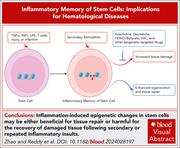
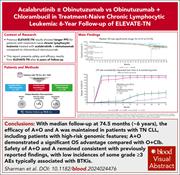
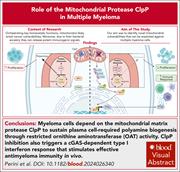
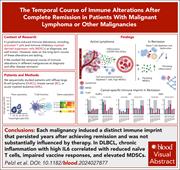
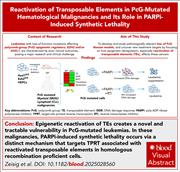
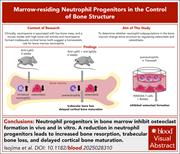
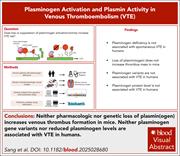


ELEVATE-ing clinical trial reporting in CLL
Clinical Trials & Observations